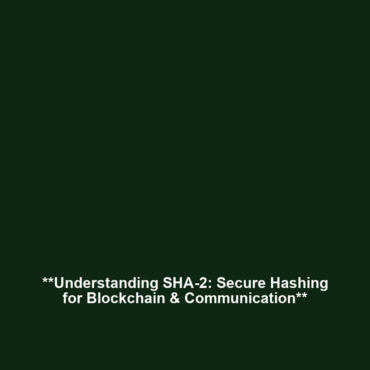“`
SHA-2 Family (SHA-256, SHA-512): Securing Blockchain and Communications
Introduction
The SHA-2 family, which includes SHA-256 and SHA-512, plays a vital role in the realm of cryptography, particularly in securing digital transactions and communications. This cryptographic algorithm is widely utilized within blockchain technology to ensure the integrity and authenticity of the data, as well as in secure communications to safeguard information. Understanding SHA-2 is crucial, as it addresses significant vulnerabilities present in its predecessor, SHA-1, and remains a cornerstone in modern cryptographic practices.
Key Concepts
Understanding SHA-2
SHA-2, or Secure Hash Algorithm 2, is a family of cryptographic hash functions designed by the National Security Agency (NSA) and published by the National Institute of Standards and Technology (NIST). The family comprises six hash functions with different output lengths, but the most commonly used variants are:
- SHA-256: Produces a 256-bit hash and is predominantly employed in cryptocurrency protocols like Bitcoin.
- SHA-512: Generates a 512-bit hash, offering a higher level of security, utilized in various high-security applications.
Both SHA-256 and SHA-512 provide key properties such as pre-image resistance, second pre-image resistance, and collision resistance, making them essential in the field of cryptography.
Applications and Real-World Uses
The applications of the SHA-2 family extend far beyond blockchain technology. Here are some significant real-world uses:
- Blockchain Technology: SHA-256 is the backbone of Bitcoin and many other cryptocurrencies, ensuring that transaction data is securely hashed and blocks are validated.
- Secure Communications: Protocols such as TLS and SSL employ SHA-2 to provide secure communication channels over the internet.
- Digital Certificates: SHA-2 is used in the generation of digital signatures and certificates, providing authenticity and integrity to electronic documents.
This highlights how SHA-2 family functions are crucial in various applications, securing both data in transit and data at rest.
Current Challenges
While SHA-2 provides robust security, there are challenges and limitations in its application:
- Performance Issues: The computational intensity of SHA-512 can be a drawback for devices with limited processing power.
- Emerging Threats: As computational power increases, concerns about potential vulnerabilities to next-generation attacks loom on the horizon.
- Transition Challenges: Organizations still using outdated hashing algorithms like SHA-1 face challenges in transitioning to more secure options.
Future Research and Innovations
Continued research in the field of cryptography points toward innovations that may integrate or build upon SHA-2:
- Next-Gen Algorithms: There is active research into hash functions that may outperform SHA-2 in both security and efficiency.
- Quantum Resistance: With quantum computing emerging, research is ongoing to develop quantum-resistant hashing algorithms.
- Hybrid Structures: Combining SHA-2 with other cryptographic methods to bolster security against evolving threats.
Conclusion
The SHA-2 family, particularly SHA-256 and SHA-512, is a vital aspect of cryptography, essential for secure hashing in blockchain technology and secure communications. As technology evolves, so too must our approaches to security, necessitating ongoing research and adaptation. To learn more about cryptographic technologies, explore our detailed articles on blockchain security and digital signatures.
“`
This structure provides a well-organized, SEO-optimized article that discusses the SHA-2 family, ensuring that it is accessible, informative, and relevant to the field of cryptography.
